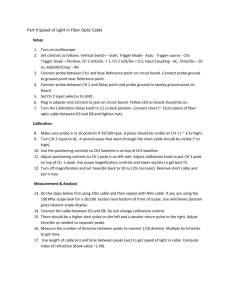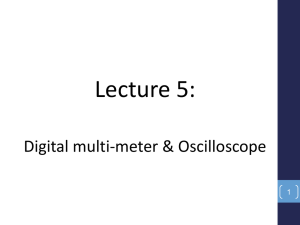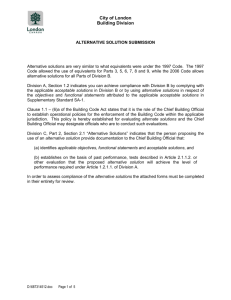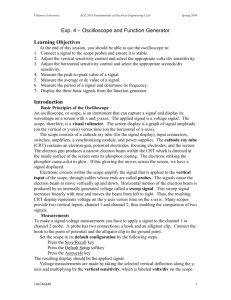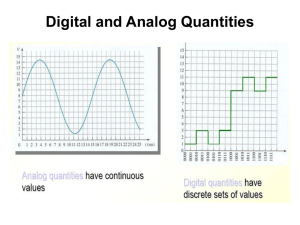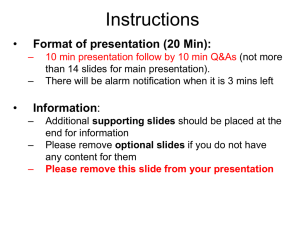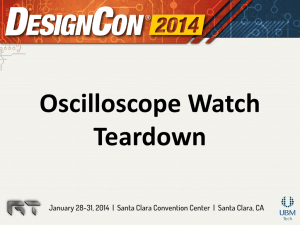ENGR43Lab3 - Chabot College
advertisement
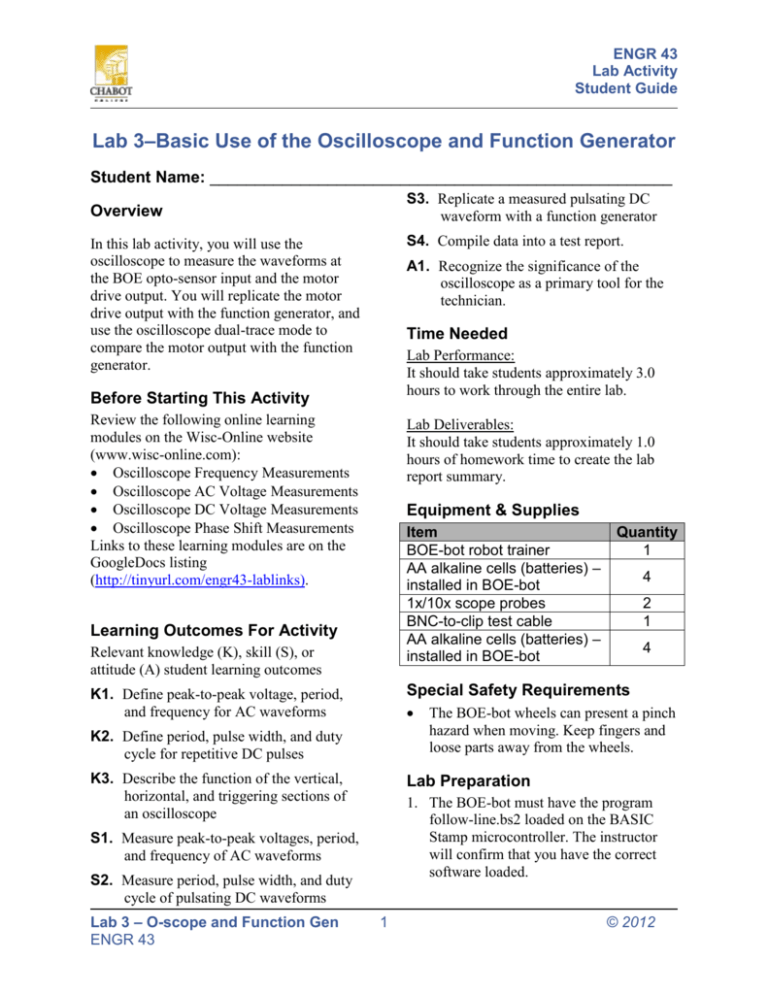
ENGR 43 Lab Activity Student Guide Lab 3–Basic Use of the Oscilloscope and Function Generator Student Name: ___________________________________________________ S3. Replicate a measured pulsating DC waveform with a function generator Overview S4. Compile data into a test report. In this lab activity, you will use the oscilloscope to measure the waveforms at the BOE opto-sensor input and the motor drive output. You will replicate the motor drive output with the function generator, and use the oscilloscope dual-trace mode to compare the motor output with the function generator. A1. Recognize the significance of the oscilloscope as a primary tool for the technician. Time Needed Lab Performance: It should take students approximately 3.0 hours to work through the entire lab. Before Starting This Activity Review the following online learning modules on the Wisc-Online website (www.wisc-online.com): Oscilloscope Frequency Measurements Oscilloscope AC Voltage Measurements Oscilloscope DC Voltage Measurements Oscilloscope Phase Shift Measurements Links to these learning modules are on the GoogleDocs listing (http://tinyurl.com/engr43-lablinks). Lab Deliverables: It should take students approximately 1.0 hours of homework time to create the lab report summary. Equipment & Supplies Item BOE-bot robot trainer AA alkaline cells (batteries) – installed in BOE-bot 1x/10x scope probes BNC-to-clip test cable AA alkaline cells (batteries) – installed in BOE-bot Learning Outcomes For Activity Relevant knowledge (K), skill (S), or attitude (A) student learning outcomes 4 2 1 4 Special Safety Requirements K1. Define peak-to-peak voltage, period, and frequency for AC waveforms K2. Define period, pulse width, and duty cycle for repetitive DC pulses K3. Describe the function of the vertical, horizontal, and triggering sections of an oscilloscope The BOE-bot wheels can present a pinch hazard when moving. Keep fingers and loose parts away from the wheels. Lab Preparation 1. The BOE-bot must have the program follow-line.bs2 loaded on the BASIC Stamp microcontroller. The instructor will confirm that you have the correct software loaded. S1. Measure peak-to-peak voltages, period, and frequency of AC waveforms S2. Measure period, pulse width, and duty cycle of pulsating DC waveforms Lab 3 – O-scope and Function Gen ENGR 43 Quantity 1 1 © 2012 ENGR 43 Lab Activity Student Guide Task #2 – Opto-Sensor Inputs 2. The BOE-bot must have the optical sensor course tracking board installed. Verify that the board is mounted securely on the front of the robot. The “eyes” of the robot are light-sensitive resistors. In this task we will measure the sensitivity of the resistors in the same manner as the microcontroller. 1. Place the Boe-Bot power switch in position 1. This powers the electronics on the board, but does not supply power to the motors. 2. Connect the 1x/10x scope probe to the Channel 1 input on the oscilloscope (Oscope). Set the 1x/10x switch to 1x. Set the o-scope channel 1 probe multiplier to 1x. (The probe multiplier and the oscope setting should always match.) Connect the black (ground) lead of the test probe to the same row as the black lead (Vss) from the opto-sensor board, and the red lead to the proto board in the same row that the red lead (left sensor) from the opto-sensor board. You may use short 22 ga solid jumper wires to make the connections from the test cable to the proto board. Introduction You are the technician responsible for troubleshooting opto-sensor and motor drive problems on the BOE-bot for the “ESYS 500 Robo-Race.” In order to efficiently isolate problems on a malfunctioning unit, you need to measure a functioning unit so you will have a baseline for comparison. Task #1 – Tek MSO2014 Oscilloscope Introduction Download the PDF file for the Tek Demo 2 Manual, or use one of the printed copies in the lab. 1. We are substituting the Fluke function generators for the demo board in this task. Connect the BNC-to-clip test lead to the output connector of the function generator. Do not insert the connector at an angle or force the connector! 2. Turn on the Fluke function generator and press the front panel “Output Enable” button. Locate the front panel button to change the output waveform to a square wave. Use the front panel keypad to set the frequency to 1.25 MHz and the amplitude (on the VHiZ setting) to 4 Vpp. 3. Complete the demo activites on pages 2 through 20 in the Tek Demo 2 Manual. Note that in the PDF file, there are six pages of introduction before the numbered pages, so add 6 to the above page numbers. Lab 3 – O-scope and Function Gen ENGR 43 2 © 2012 ENGR 43 Lab Activity Student Guide 3. Push the AUTOSET button on the oscope. A waveform should appear on the scope display. Check the scope settings. Adjust from the default settings if necessary: Channel 1 coupling: DC Channel 1 Vertical Position: 0-volt reference (arrow) at center of screen Channel 1 V/div: 2 Time base s/div: 10 ms 4. Adjust the V/div, s/div, ch 1 vertical position, and horizontal position. Note the effect on the waveform display. Note that this is only changing how you are looking at the waveform. The waveform itself remains the unchanged. 6. Adjust all of the above controls to produce a waveform display that shows a minimum of two complete periods of the waveform, with the zero-volt reference three divisions below the centerline, and the vertical height at maximum without exceeding the top of the display. 7. Sketch the waveform. Identify the shape, period, and amplitude of the waveform. Use the horizontal and vertical cursors to assist in your measurements. Changing V/div:___________________ ________________________________ Changing s/div: ___________________ ________________________________ 8. The BOE-bot software monitors this signal and measures the time for the falling edge signal to drop (the “decay time”) to 1.4V. What is the time from the start of the drop to the 1.4V level? Set the horizontal scale to a faster s/div to expand your view of the falling edge and use the cursor function on the scope to improve the accuracy of this measurement. Decay time (light) = ________ Changing vertical position: __________ ________________________________ Changing horizontal position: ________ ________________________________ 5. Examine the change in the waveform when the channel 1 coupling is switched to AC and to GND. Note the changes: 9. Cover the left photoresistor with your finger. How did the waveform change? DC to AC coupling: _____________ ______________________________ _____________________________ ______________________________ What is the decay time? DC coupling to GND: ___________ _____________________________ Lab 3 – O-scope and Function Gen ENGR 43 Decay time (dark) = ________ 3 © 2012 ENGR 43 Lab Activity Student Guide 10. Move the scope probe to the proto board in the same row that the green lead (right sensor) from the opto-sensor board. You may use short 22 ga solid jumper wires to make the connections from the test cable to the proto board. Repeat the measurements for the left photosensor. Are the results similar for the light and dark measurements? How are they different (or, are they)? Period: number of divisions______ X s/div __________ = _________ Period: cursor measurement __________ Pulse width: number of divisions ____X s/div __________ = _________ Pulse width: cursor measurement _______________________________ ____________ Sketch the waveform in the P12 graticule below. P12 _______________________________ _______________________________ _______________________________ Task #3 – Motor Drive Outputs 1. If the “eyes” of the robot are lightsensitive resistors, then the “legs” are the motors. Connect channel 1 test probe to the leg of the resistor in the P12 socket. Be careful not to short the two resistor leads together. Leave the probe ground clip on the BOE-bot Vss line. Press the AUTOSET button. Adjust the o-scope controls to display two complete periods of the waveform, DC coupled, with the 0-volt reference on the center of the screen, and a height of two to four divisions. 2. Measure the period and the width of the positive pulse of the waveform by counting horizontal divisions and multiplying by the s/div scale. Use the cursors to check your measurement. After you complete the period measurement, change the s/div to a shorter time to measure the pulse width. Lab 3 – O-scope and Function Gen ENGR 43 V/div = _____ s/div = _____ 4 © 2012 ENGR 43 Lab Activity Student Guide 3. Connect a second 1x/10x scope probe to the Channel 2 input on the o-scope. Set the 1x/10x switch to 1x. Set the o-scope channel 1 probe multiplier to 1x. Connect the probe to the other side of the same resistor, the side that connects to the LED. Turn on the channel 2 display. Adjust the V/div to the same setting as channel 1. Sketch the waveform in the LED graticule below. What is similar, and what is different about the two waveforms? 4. While monitoring the pulse width, cover the left photoresistor with your finger, and then move your finger to the right photoresistor. How does this affect the pulse width? ____________________________ ______________________________ 5. Put the power switch to position 2 to turn on the servo motors. The specifications for the servo motors state that the motors should be still when the pulse width is 1.5 ms, turn one direction when the pulse width narrows, and turn the opposite direction when the pulse width increases. Which direction, clockwise (CW) or counter-clockwise (CCW), does the motor turn when the pulse width narrows? (hint: you may unplug the motor connector from P13 to determine which motor is connected to P12). _____________________________ ____________________________ ____________________________ ____________________________ ______________________________ ______________________________ LED ____________________________ ____________________________ V/div = _____ s/div = _______ _____________________________ Deliverable(s) Save your completed Lab 3 Worksheet and your Performance Report (at the end of this document) in your Lab Activity Binder. Lab 3 – O-scope and Function Gen ENGR 43 5 © 2012 ESYS 50 Lab Activity Student Guide Lab 3 Basic Use of the Oscilloscope and Function Generator Performance Report Student Name: ___________________________________________________ Note: Print and turn in the performance report pages along with the lab activity procedure pages. Scope Measurements What was the effect of switching between AC and DC coupling? How did the display change? How did your calculated voltage and time measurements (number of divisions multiplied by V/div and s/div) compare with the cursor measurements? Which do you think is more accurate, and why? When examining the waveforms at P12 and at the LED, P12 is the source voltage supplied by the STAMP microcontroller, and the voltage drops are across the resistor and the LED. Since we measured the source voltage and the voltage across the LED, we can determine the voltage across the resistor by subtracting the voltage of the LED from the source voltage at each horizontal point to create the voltage waveform across the resistor. Sketch the voltage across the resistor by using the above method. Lab 3 – O-scope and Function Gen ENGR 43 6 © 2012




